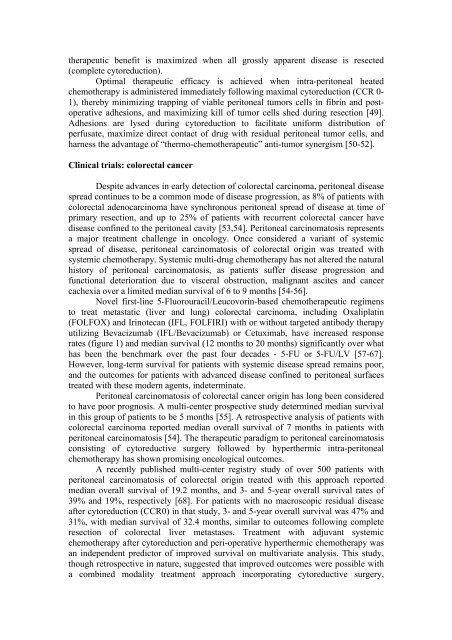Evidence-based medicine in the treatment of ... - Alfredo Garofalo
Evidence-based medicine in the treatment of ... - Alfredo Garofalo
Evidence-based medicine in the treatment of ... - Alfredo Garofalo
You also want an ePaper? Increase the reach of your titles
YUMPU automatically turns print PDFs into web optimized ePapers that Google loves.
<strong>the</strong>rapeutic benefit is maximized when all grossly apparent disease is resected<br />
(complete cytoreduction).<br />
Optimal <strong>the</strong>rapeutic efficacy is achieved when <strong>in</strong>tra-peritoneal heated<br />
chemo<strong>the</strong>rapy is adm<strong>in</strong>istered immediately follow<strong>in</strong>g maximal cytoreduction (CCR 0-<br />
1), <strong>the</strong>reby m<strong>in</strong>imiz<strong>in</strong>g trapp<strong>in</strong>g <strong>of</strong> viable peritoneal tumors cells <strong>in</strong> fibr<strong>in</strong> and postoperative<br />
adhesions, and maximiz<strong>in</strong>g kill <strong>of</strong> tumor cells shed dur<strong>in</strong>g resection [49].<br />
Adhesions are lysed dur<strong>in</strong>g cytoreduction to facilitate uniform distribution <strong>of</strong><br />
perfusate, maximize direct contact <strong>of</strong> drug with residual peritoneal tumor cells, and<br />
harness <strong>the</strong> advantage <strong>of</strong> “<strong>the</strong>rmo-chemo<strong>the</strong>rapeutic” anti-tumor synergism [50-52].<br />
Cl<strong>in</strong>ical trials: colorectal cancer<br />
Despite advances <strong>in</strong> early detection <strong>of</strong> colorectal carc<strong>in</strong>oma, peritoneal disease<br />
spread cont<strong>in</strong>ues to be a common mode <strong>of</strong> disease progression, as 8% <strong>of</strong> patients with<br />
colorectal adenocarc<strong>in</strong>oma have synchronous peritoneal spread <strong>of</strong> disease at time <strong>of</strong><br />
primary resection, and up to 25% <strong>of</strong> patients with recurrent colorectal cancer have<br />
disease conf<strong>in</strong>ed to <strong>the</strong> peritoneal cavity [53,54]. Peritoneal carc<strong>in</strong>omatosis represents<br />
a major <strong>treatment</strong> challenge <strong>in</strong> oncology. Once considered a variant <strong>of</strong> systemic<br />
spread <strong>of</strong> disease, peritoneal carc<strong>in</strong>omatosis <strong>of</strong> colorectal orig<strong>in</strong> was treated with<br />
systemic chemo<strong>the</strong>rapy. Systemic multi-drug chemo<strong>the</strong>rapy has not altered <strong>the</strong> natural<br />
history <strong>of</strong> peritoneal carc<strong>in</strong>omatosis, as patients suffer disease progression and<br />
functional deterioration due to visceral obstruction, malignant ascites and cancer<br />
cachexia over a limited median survival <strong>of</strong> 6 to 9 months [54-56].<br />
Novel first-l<strong>in</strong>e 5-Fluorouracil/Leucovor<strong>in</strong>-<strong>based</strong> chemo<strong>the</strong>rapeutic regimens<br />
to treat metastatic (liver and lung) colorectal carc<strong>in</strong>oma, <strong>in</strong>clud<strong>in</strong>g Oxaliplat<strong>in</strong><br />
(FOLFOX) and Ir<strong>in</strong>otecan (IFL, FOLFIRI) with or without targeted antibody <strong>the</strong>rapy<br />
utiliz<strong>in</strong>g Bevacizumab (IFL/Bevacizumab) or Cetuximab, have <strong>in</strong>creased response<br />
rates (figure 1) and median survival (12 months to 20 months) significantly over what<br />
has been <strong>the</strong> benchmark over <strong>the</strong> past four decades - 5-FU or 5-FU/LV [57-67].<br />
However, long-term survival for patients with systemic disease spread rema<strong>in</strong>s poor,<br />
and <strong>the</strong> outcomes for patients with advanced disease conf<strong>in</strong>ed to peritoneal surfaces<br />
treated with <strong>the</strong>se modern agents, <strong>in</strong>determ<strong>in</strong>ate.<br />
Peritoneal carc<strong>in</strong>omatosis <strong>of</strong> colorectal cancer orig<strong>in</strong> has long been considered<br />
to have poor prognosis. A multi-center prospective study determ<strong>in</strong>ed median survival<br />
<strong>in</strong> this group <strong>of</strong> patients to be 5 months [55]. A retrospective analysis <strong>of</strong> patients with<br />
colorectal carc<strong>in</strong>oma reported median overall survival <strong>of</strong> 7 months <strong>in</strong> patients with<br />
peritoneal carc<strong>in</strong>omatosis [54]. The <strong>the</strong>rapeutic paradigm to peritoneal carc<strong>in</strong>omatosis<br />
consist<strong>in</strong>g <strong>of</strong> cytoreductive surgery followed by hyper<strong>the</strong>rmic <strong>in</strong>tra-peritoneal<br />
chemo<strong>the</strong>rapy has shown promis<strong>in</strong>g oncological outcomes.<br />
A recently published multi-center registry study <strong>of</strong> over 500 patients with<br />
peritoneal carc<strong>in</strong>omatosis <strong>of</strong> colorectal orig<strong>in</strong> treated with this approach reported<br />
median overall survival <strong>of</strong> 19.2 months, and 3- and 5-year overall survival rates <strong>of</strong><br />
39% and 19%, respectively [68]. For patients with no macroscopic residual disease<br />
after cytoreduction (CCR0) <strong>in</strong> that study, 3- and 5-year overall survival was 47% and<br />
31%, with median survival <strong>of</strong> 32.4 months, similar to outcomes follow<strong>in</strong>g complete<br />
resection <strong>of</strong> colorectal liver metastases. Treatment with adjuvant systemic<br />
chemo<strong>the</strong>rapy after cytoreduction and peri-operative hyper<strong>the</strong>rmic chemo<strong>the</strong>rapy was<br />
an <strong>in</strong>dependent predictor <strong>of</strong> improved survival on multivariate analysis. This study,<br />
though retrospective <strong>in</strong> nature, suggested that improved outcomes were possible with<br />
a comb<strong>in</strong>ed modality <strong>treatment</strong> approach <strong>in</strong>corporat<strong>in</strong>g cytoreductive surgery,



